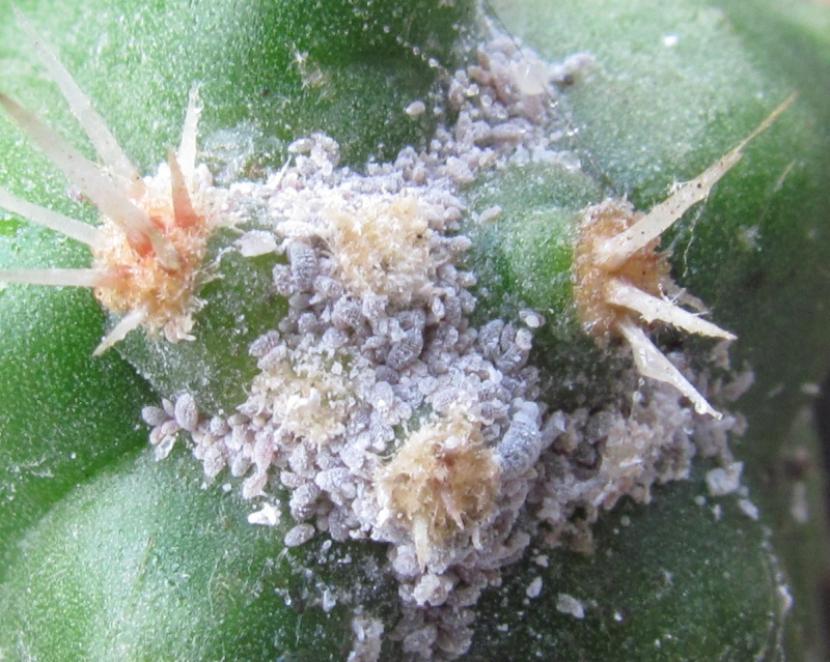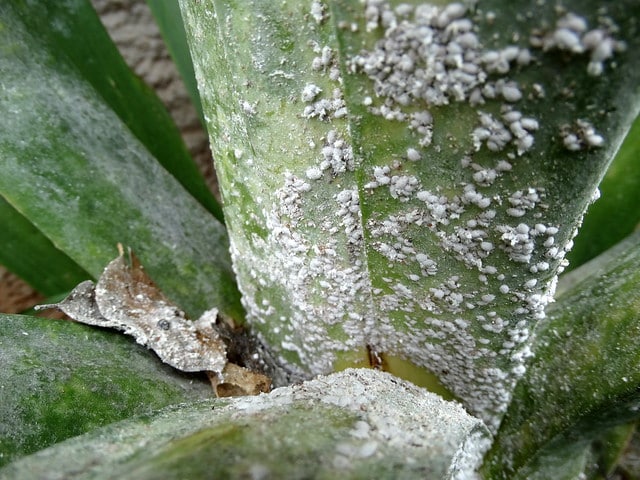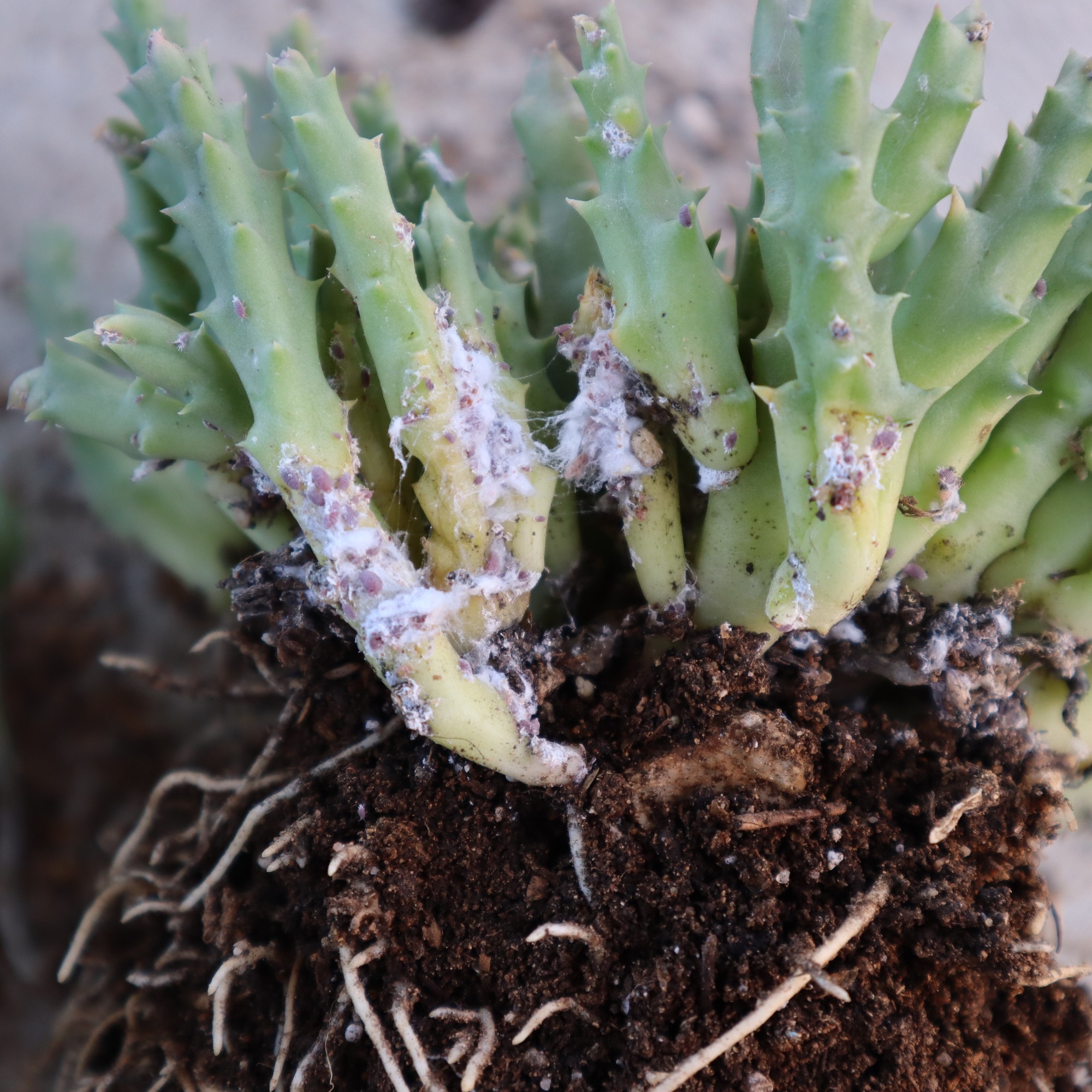
Cottony Mealybug
Cottony Mealybug
Pathogen:
Insect
Type:
Risk:
HIGH
Cochinillas


WHO CAUSES IT?
The cottony mealybug includes different species within the superfamily Coccoidea, standing out for its ability to infest various plants, including cacti. These insects go through several stages of development, beginning with the laying of eggs by adult females in protected sites on the plant. Upon hatching, the nymphs, known as "crawlers", disperse in search of places where they can feed on the cactus sap. The nymphs go through several molts before reaching the adult phase, where the females become sedentary and cover themselves with a white waxy substance that provides them with protection. The males, which are winged and live only a few days, are dedicated exclusively to fertilizing the females. Reproduction of cottony mealybugs can be both sexual and asexual, depending on the species. These pests can produce several generations in a year, especially in hot and humid climates, which facilitates their proliferation and potential damage to host plants.
SYMPTOMS
Cottony mealybug infestation in cacti causes a disease that significantly weakens the plants by sucking their sap, interfering with their ability to carry out photosynthesis and other vital processes. This attack can lead to reduced growth, chlorosis and, in severe cases, plant death. Additionally, mealybugs excrete a sticky substance called honeydew, which attracts sooty fungi, adding more stress to the plant and further reducing its photosynthetic capacity.
- Presence of a white cottony substance on the surface of the cactus.
- Discoloration and yellowing of fabrics.
- Appearance of sticky honeydew on the surface of the cactus.
- Growth of sooty fungi on molasses.
- Loss of vigor and delay in growth.
- Death of the plant in serious infestations.

TEMPERATURE AND HUMIDITY
20°C a 30°C
60% a 80%
TRANSMISSION PATHS
Direct contact between plants, Wind, Contaminated tools, Vector animals, Movement of infested plants
Do you want to remove this pest? Choose how you want to treat it.
TREATMENTS
Chemical treatment
• ABAMECTIN 0.0015% + PYRETHRINS 0.02% [AL] P/V
• RAPESEAL OIL 0.825% + PYRETHRINS 0.018% [AL] P/V
• RAPE OIL 1.53% [AL] P/V
• RAPE OIL 1.69% ( ) [AL] P/V
• RAPE OIL 77.7% [EC] P/V
• RAPE OIL 848.24 g/l [EC] P/V
• ORANGE OIL 60g/L [ME] P/S
• PARAFFIN OIL (CAS [97862-82-3]) 40% [EW] P/V
• PARAFFIN OIL (CAS [97862-82-3]) 80% [EC] P/V
• ACETAMIPRID 0.005% [AL] P/V
• ACETAMIPRID 20% [SG] P/P
• ACETAMIPRID 20% [SP] P/P
• AZADIRACTIN 1% (AS AZADIRACTIN A) [EC] P/V
• Azadirachtin 2.6% (AS AZADIRACTIN A) [EC] P/V
• CYPERMETHRIN 5% [EC] P/V
• CYPERMETHRIN 50% [EC] P/V
• DELTAMETHRIN 1.57% [SC] P/V
• DELTAMETHRIN 2.5% [EC] P/V
• FLUPIRADIFURONE 0.008% [AL] P/V
• LAMBDA CYHALOTHRIN 5% [EG] P/P
• PYRIPROXIFEN 10% [EC] P/V
• POTASSIUM SALTS OF FATTY ACIDS C14-C20 48% [EW] P/V
• POTASSIUM SALTS OF VEGETABLE FATTY ACIDS 13.04% [SL] P/V
• POTASSIUM SALTS OF UNSATURATED FATTY ACIDS C7-C18 & C18 (CAS [67701-09-1] 515g/L [SL] P/V
• POTASSIUM SALTS OF UNSATURATED FATTY ACIDS C7-C18 & C18 10.2g/L [AL] P/V
• SPIROMESIFEN 24% [SC] P/V
• TAU-FLUVALINATE 24% [EW] P/V
Authorized treatments in organic farming
• RAPESEAL OIL 0.825% + PYRETHRINS 0.018% [AL] P/V
• RAPE OIL 1.53% [AL] P/V
• RAPE OIL 1.69% ( ) [AL] P/V
• RAPE OIL 77.7% [EC] P/V
• RAPE OIL 848.24 g/l [EC] P/V
• ORANGE OIL 60g/L [ME] P/S
• PARAFFIN OIL (CAS [97862-82-3]) 40% [EW] P/V
• PARAFFIN OIL (CAS [97862-82-3]) 80% [EC] P/V
• AZADIRACTIN 1% (AS AZADIRACTIN A) [EC] P/V
• Azadirachtin 2.6% (AS AZADIRACTIN A) [EC] P/V
• LAMBDA CYHALOTHRIN 5% [EG] P/P
• POTASSIUM SALTS OF FATTY ACIDS C14-C20 48% [EW] P/V
• POTASSIUM SALTS OF VEGETABLE FATTY ACIDS 13.04% [SL] P/V
• POTASSIUM SALTS OF UNSATURATED FATTY ACIDS C7-C18 & C18 (CAS [67701-09-1] 515g/L [SL] P/V
• POTASSIUM SALTS OF UNSATURATED FATTY ACIDS C7-C18 & C18 10.2g/L [AL] P/V
Traitements biologiques
• CRYPTOLAEMUS MONTROUZIERI
Recommendations
- Regularly inspect cacti for the presence of cottony mealybugs and act quickly in case of infestation.
- Use a mild soap and water solution to wash the affected areas and remove the scale insects.
- Apply horticultural oils or specific insecticides recommended for controlling mealybugs, always following the manufacturer's instructions.
- Keep plants well nourished and in optimal health conditions to increase their resistance to pests.
- Introduce or encourage the presence of natural enemies of the mealybug, such as ladybugs or parasitoid wasps.
- Ensure good air circulation around the plants to reduce humidity and favorable conditions for mealybugs.
- Avoid excessive use of fertilizers with high nitrogen content, as they promote the growth of succulent tissues susceptible to infestations.
- Implement a crop rotation program and hygiene practices in the garden to prevent the reintroduction of mealybugs.
- Consider the use of physical barriers, such as netting, to protect plants from new infestations.
Sponsored link
Sponsored link
Sponsored link
Sponsored link
Sponsored link
Sponsored link
Effective against all types of fungi
TREATMENTS
Homemade treatments
There are no home treatments
Natural allies
Chemical treatments
There are no treatments for this disease. Treatments are directed at the insect vectors that transmit it. See insect treatments.
RECOMMENDATIONS
- Check the back of the leaves frequently, especially in dry weather.
- Spray water on the leaves to increase humidity and prevent them from settling.
- Keep plants healthy with good watering and adequate light.
- If you see cobwebs or damage, clean the leaves with a damp cloth or pressurized water.
- Use potassium soap or neem oil every few days until they disappear.
REPELLENT PLANTS
Rosemary, Dill, Coriander
RECOMMENDED PRODUCTS
Sponsored link
Sponsored link
Sponsored link
Sponsored link
Sponsored link
Sponsored link
Effective against all types of fungi
*The recommended treatments are still recommendations according to the databases of the authorities and at no time do they replace the guidelines established according to the legislation of each country
*The products shown are recommendations and are not our own products. As Amazon Associates, we earn revenue from purchases of recommended products.




















